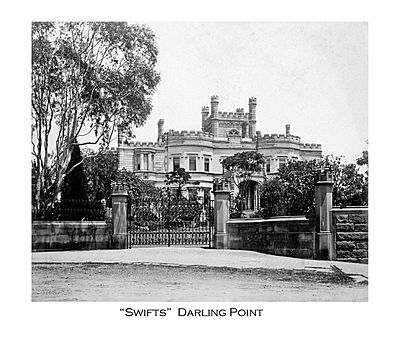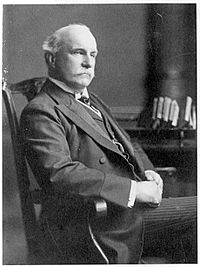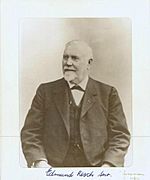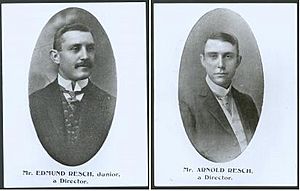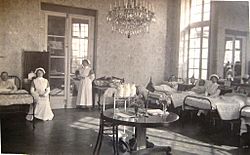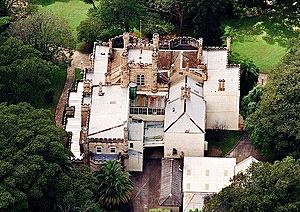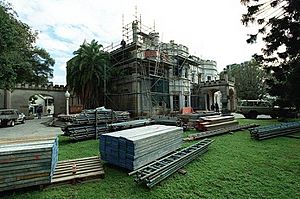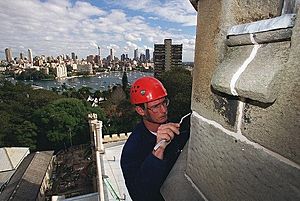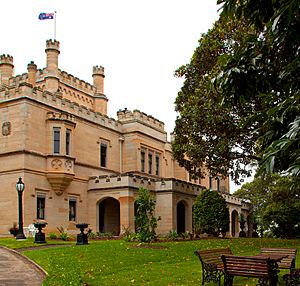Swifts, Darling Point facts for kids
Quick facts for kids Swifts |
|
|---|---|
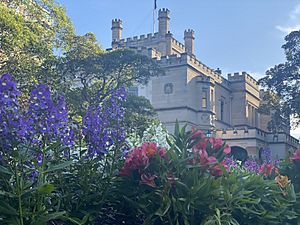 |
|
| Alternative names | The Swifts |
| General information | |
| Type | Heritage listed house |
| Architectural style | Gothic Revival |
| Location | 68 Darling Point Road, Darling Point, Municipality of Woollahra, New South Wales, Australia |
| Coordinates | 33°52′10″S 151°14′18″E / 33.8695°S 151.2383°E |
| Groundbreaking | 1873 |
| Completed | 1877 |
| Renovated | from 1997 ongoing |
| Client | Sir Robert Lucas Lucas-Tooth |
| Owner | Dr Shane Moran |
| Design and construction | |
| Architect | G. A. Morrell |
| Awards and prizes | Governor Lachlan Macquarie Award (2012) |
| Official name | The Swifts, 68 Darling Point Rd, Darling Point, NSW, Australia |
| Type | Defunct register |
| Designated | 21 October 1980 |
| Reference no. | 2577 |
| Type | Historic |
| Place File No. | 1/12/041/0091 |
| Official name | Swifts |
| Type | State heritage (complex / group) |
| Designated | 2 April 1999 |
| Reference no. | 146 |
| Type | Other – Landscape – Cultural |
| Category | Landscape – Cultural |
Swifts (also known as The Swifts) is a grand old house in Darling Point, Sydney. It looks like a castle with its towers and battlements. This style is called Gothic Revival. Swifts is one of the few large private homes left on the southern side of Sydney Harbour. Many people say it's the most impressive house still standing in Sydney.
The house has a special message carved into its eastern side. It says Perseverantia Palmam Obtinebit. This is Latin for "perseverance gains the prize". This motto really fits the house and the families who have lived there.
G. A. Morrell designed Swifts. It was built in different stages from about 1873 to 1882. Sir Robert Lucas Lucas-Tooth, a famous Australian brewer, was the first owner. In the 1880s, he made the house look even more like his family home in England, called Great Swifts Manor. Later, another brewer, Edmund Resch, bought the house. His son, Edmund Resch Jr, left the house to the Roman Catholic Church when he passed away in 1963.
In 1997, the Moran family bought Swifts. The house was in bad shape, almost falling apart. The Morans saved it by completely restoring and renovating it. Dr Shane Moran is the current owner of Swifts.
Contents
- Exploring the History of Swifts
- Why Swifts is Special: Heritage and Culture
- Swifts in Popular Culture
Exploring the History of Swifts
Early Days: Yarranabbe and Mrs Darling's Point
The land where Swifts stands was originally home to the Cadigal people. They were an Aboriginal clan from the Sydney area. This place was known as "Yarranabbe" from at least 1795.
In the 1830s, Governor Darling set aside this area for sale. He called it 'Mrs Darling's Point' to honor his wife, Eliza Darling. Over time, the "Mrs" was dropped, and it became simply Darling Point.
Building Swifts: The Tooth Family Era (1872–1900)
In 1872, Robert Lucas Tooth bought the land. He was a nephew of the Tooth family, who owned the Kent Brewery. He later became Sir Robert Lucas Lucas-Tooth.
Original Construction and Expansion (1873–1900)
Construction on the first part of Swifts began around 1873. It was a simpler two-story house at first. By 1877, the house was expanded with a sandstone tower and castle-like features. Beatrice Maude, Sir Robert's daughter, even helped lay a foundation stone in 1876. The house was designed to look like the family's English home, "Great Swifts".
In 1882, a famous architect named Gustavus Alphonse Morrell was hired. He designed more expansions for Swifts. His plans included sandstone walls, towers, and a long covered entrance, similar to Sydney's Government House. The house was built to be very modern for its time, with many rooms for servants. In 1889, Sir Robert Lucas-Tooth and his family moved to England, but he often visited Australia.
The Resch Family Takes Over (1900–1964)
Edmund Resch Sr (1900–1928)
In 1900, another brewer, Edmund Resch, bought Swifts. He was from Germany and had built his own brewing business in Sydney. He made only a few changes to the house, like redecorating some rooms and adding a tennis court. This suggests he liked the house as it was.
During World War I, there was a lot of anti-German feeling in Australia. Edmund Resch helped the war effort and supported his employees who joined the army. However, he was briefly held under house arrest at Swifts until the war ended. Edmund Resch Sr passed away at Swifts in 1923.
Edmund Resch Jr and Arnold Resch (1929–1963)
Edmund Resch Sr's sons, Edmund Jr and Arnold, took over the family business. In 1929, their brewery was bought by Tooth & Co Ltd. The Resch brothers generously gave £30,000 to their former employees.
After their mother passed away in 1927, the brothers disagreed about the future of Swifts. In 1928, Edmund Resch Jr bought the house at an auction, becoming its sole owner. Arnold Resch later moved to the Channel Islands.
Edmund Resch Jr made changes to improve the living conditions for his staff. He also redecorated the inside of the main house. Swifts often appeared in magazines, showing tennis parties and balls held at the "castle-like home".
Swifts During World War II: A Rest Centre
During World War II, the Resch family allowed parts of Swifts to be used as a rest center for wounded soldiers. In 1942, the house's large ballroom was turned into a space for over 100 people in emergencies. It also had rooms for treating soldiers who were suffering from shock. Local volunteers used the center to knit and sew for the Red Cross.
Edmund Resch Jr's Legacy
Edmund Resch Jr died at Swifts in 1963. He left most of his large fortune, including Swifts, to the Sisters of Charity and the Roman Catholic Church. This gift helped build the new St Vincent's Private Hospital in Sydney. This generous act saved Swifts from being torn down and the land being divided up, which was happening to many other grand houses at the time.
The Catholic Church Era (1964–1986)
For several decades, Swifts became the home of the Cardinals of the Roman Catholic Archdiocese of Sydney.
The house was slightly changed for the Church's use. The former ballroom became a chapel, named St Edmunds, that could seat 200 people. In 1964, Cardinal Gilroy moved into Swifts as the official home of the Archbishop of Sydney.
Swifts hosted two Popes during this time. Pope Paul VI stayed at Swifts in 1970, and Pope John Paul II stayed there during his visit in 1986.
After Cardinal Gilroy passed away in 1970, Cardinal James Darcy Freeman lived at Swifts. He was followed by Cardinal Edward Bede Clancy in 1983.
Swifts Becomes Heritage-Listed
By 1983, people realized how important Swifts was. The NSW Heritage Council wanted to protect it permanently. Despite some objections, Swifts was officially listed on the New South Wales State Heritage Register in April 1984. This meant it was protected by law.
A Time of Disrepair (1986–1997)
In 1986, the Catholic Church sold Swifts to a company called Minjar Holdings Pty Ltd. The sale price was the highest ever paid for a home in Australia at that time.
However, the new owners faced financial problems. By the early 1990s, Swifts began to fall apart. The roof leaked, and parts of it even collapsed, causing damage inside. The sandstone walls also started to crumble.
Because Swifts was in danger of being destroyed, the NSW Heritage Council and local residents stepped in to help. The house was put up for sale again in 1996 and 1997, but no one bought it.
Restoration by the Moran Family (1997–Present)
In April 1997, the Moran family bought Swifts. They own private health and aged care facilities. They hired expert architects and builders to restore the house. This was a huge job, involving fixing the stone walls, roof, and collapsed ceilings. It was one of the biggest and most expensive private home restorations in Sydney.
The restoration focused on how Swifts looked during the Tooth family's time in the 1870s. This was because there was a lot of evidence, like old photos, from that period. The house now looks like a tribute to the grand Victorian style and Sir Robert Lucas-Tooth.
The restoration work taught experts a lot about how wealthy families and their servants lived in the late 1800s. It showed the amazing detail in the main rooms and the practical design of the servants' areas. For example, the "Moorish smoking room" is very unique in Australia.
In 1998, a tornado hit Darling Point, damaging some of the newly restored roof and decorations. They had to be redone. The gardens were also restored with the help of an expert.
In 2013, Dr Shane Moran became the sole owner of Swifts. He and his wife were married nearby and held their reception at Swifts when it was partly renovated. Dr Moran is a descendant of Thomas Barker, who first bought the land for Swifts in 1833.
Dr Moran continues to work on Swifts. He has added a new conservatory and a swimming pool. He has also done a lot of work on the gardens. Sir Robert Lucas-Tooth's wish for his "work to go on" has certainly come true.
Why Swifts is Special: Heritage and Culture
Heritage Significance
In 2012, Swifts won the Lachlan Macquarie Award for Heritage. This award recognized it as the best restoration project in Australia.
Swifts is important because it's a unique Australian example of a large, castle-like country house from the late 1800s. It sits beautifully on Darling Point, overlooking Sydney Harbour. Its size, sandstone walls, and Gothic style make it one of the grandest mansions in New South Wales.
Besides Government House, Sydney, Swifts is the largest Victorian Gothic Revival house left in Australia. The different decorative styles in its rooms are amazing. The ballroom and its hallway were decorated by a leading art firm of the time. The "Moorish smoking room" and other areas show incredible artistic detail.
Swifts still has its original grounds, including old statues, terrace walls, stairs, and paths from the 19th century.
Cultural Significance
Swifts shows an important time in Australia's history. It represents the rise of a wealthy upper-class, like Sir Robert Lucas-Tooth, who made their money from brewing and other businesses. The house and its gardens are rare survivors, partly thanks to the Resch family's long ownership and care.
Its connection to the Roman Catholic Church is also important. It was home to three cardinals: Gilroy, Freeman, and Clancy. The gardens at Swifts are also special. They are a great example of a landscaped garden from the late 1800s and early 1900s. They show the design trends and planting styles of that era.
Beautiful Stained Glass Window
Above the main staircase at Swifts, there's a large, original stained glass window from the 1880s. It has been fully restored. The top part of the window shows King John of England signing the Magna Carta in 1215. Below, it shows King Henry V of England after his victory at the Battle of Agincourt in 1415.
The Fincham & Hobday Organ
In 1902, a newspaper described Swifts as having a "handsome mansion with towers". It also mentioned a ballroom with paintings of famous musicians. In a special alcove, there was a large orchestral organ. It was said to be the biggest of its kind in Sydney and could play like a musical box.
In 2016, Dr Shane Moran installed a historic Australian-made pipe organ into the house. This organ was built in 1885 by Fincham & Hobday in Adelaide. It was originally for a church in Gawler, South Australia. Dr and Mrs Moran bought the organ in 2015 and had it carefully restored.
This organ is one of only three by Fincham & Hobday from the 19th century that still exists in its original form. It's the only one outside South Australia. It's known for its excellent craftsmanship, beautiful sound, and original decorations.
Official Heritage Listing of Swifts
As of 2009, Swifts is considered very important to the history of New South Wales. It's the largest Victorian Gothic Revival house in Australia, apart from Government House. It still has its original grounds, including the landscape, statues, walls, stairs, and paths. It shows how wealthy people lived in Australia in the 19th century.
Swifts is also important because it was home to two well-known Sydney business families: the Lucas-Tooth and Resch families. Its connection to the Roman Catholic Church is also significant, as it was home to three cardinals: Gilroy, Freeman, and Clancy. The building is also a great example of the work of Gustavus Alphonse Morrell, a famous Sydney architect from the late 1800s.
The gardens of Swifts were an important part of the original design. The special connection between the gardens and the mansion makes the grounds a valuable part of our heritage.
Swifts was listed on the New South Wales State Heritage Register in 1999 because:
- It has strong links to important people and groups in New South Wales history, like the Tooth and Resch brewing families, and the three cardinals.
- It shows great artistic and technical skill, with its unique design and beautiful landscaped grounds.
- It is a rare example of architect Gustavus Alphonse Morrell's work.
- It is Sydney's largest and most complete late Victorian mansion, showing how a wealthy family lived in the late 19th century, including the house, service rooms, and grounds.
Swifts in Popular Culture
Even though Swifts is a private home, it's often used for films and special cultural events. Here are some examples:
- In 2020, Swifts hosted the Sydney Harbour Concours d'Elegance. This event showcased many rare and valuable cars on the grounds.
- In 2019, Swifts was the venue for the Silver Party, a charity event that raised over $1 million for the Kids Cancer Centre at Sydney Children's Hospital.
- The house was featured in a fashion campaign for Westfield in 2017.
- It was one of the main houses in the TV series Unreal Estate in 2016, in an episode called "Grand Mansions".
- In December 2015, famous singer Dominique Choy and Taiwanese actor Sunny Wang had their wedding at Swifts.
- Swifts has been used as a filming location for several TV movies, including Mary – The Making of a Princess (where it stood in for a palace in Denmark) and Peter Allen: Not The Boy Next Door (2015).
- The house is a regular feature in the Australian drama series A Place to Call Home, where it is known as the Swanson Mansion.
- In 2012, Swifts hosted the first concert series to support the Opera Foundation Australia. The grand ballroom, with its great acoustics and paintings of musicians, was the perfect place for these performances.


